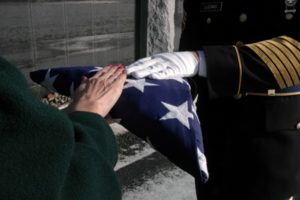The military is a closely knit subculture with many long-standing traditions. When an active duty soldier, a member of the selective reserves or a former soldier who has completed at least one full term of enlistment dies, the military offers several rituals, known as military honors, to memorialize their fallen comrade and to comfort the soldier’s family.

Credit: seattletimes.com
The three most common rituals are the playing of “Taps”, the folding of the flag and the presentation of the flag to next of kin. If the personnel are available, services may also include a rifle volley, a color guard and pallbearers.
Union General Daniel Butterfield adapted “Taps” in 1862, during the Civil War. Originally, a soldier would play it to signal lights out at sunset. Within a year, however, it was being played by both the Union and Confederate armies to honor dead soldiers. The practice originated because firing a rifle volley was too loud and might signal the troop’s location to the enemy.
During modern day military honors, a member of the military places an American flag on the closed casket after “Taps” is played. Sometimes the flag has a special significance. For instance, my father was a former Commander in Chief of the Veterans of Foreign Wars. When he died, they used the flag that flew over the VFW headquarters on the day of his death. The military places the flag so that the blue part of the flag with the white stars rests at the head and over the left shoulder.
Members of the honor guard then fold the flag 13 times in honor of the original 13 colonies. The result is a triangle showing the blue part of the flag. The red and white stripes are not evident. The triangle shape serves as a reminder of the tri-cornered hat worn by the soldiers who fought in the American Revolution.

Credit: funeralhonors.org
After the folding of the flag, a member of the honor guard presents it to the next of kin, saying, “On behalf of the President of the United States, (insert military branch) and a grateful nation, please accept this flag as a symbol of our appreciation of your loved one’s honorable and faithful service.”
When the soldiers are available, there are other military honors that loved ones can request. One is an honor guard. This consists of four to seven members who take turns, two at a time, standing watch over the casket.
Another service is the rifle volley, sometimes mistakenly referred to as the 21-gun salute. In the rifle volley, each soldier fires three volleys. This practice originated in wartime when soldiers declared a cease fire to claim and care for their dead. When the volley sounded, it meant that the dead had been cared for and the battle could resume.
Also, military members sometimes act as pallbearers, especially if there are no families or friends who can perform this function.
Six horses drawing a flag-draped casket lying on a black artillery Caisson occasionally transport prominent members of the military or heads of state who have died to the cemetery. A military flyover in the “Missing Man” formation is another show of respect.
Military honors are a mark of respect for the dead soldier. More than that, though, they offer comfort to grieving loved ones by showing them that the soldier performed a valuable service to the United States. The flag, especially, gives families something tangible to remind them that they can be proud of their loved one who died.

 Military Honors Memorialize Veterans and Comfort Survivors
Military Honors Memorialize Veterans and Comfort Survivors


 “In Case You Don’t Live Forever” by Ben Platt
“In Case You Don’t Live Forever” by Ben Platt
 Our Monthly Tip: Make an “In Case of Death” File to Ease Loved One’s Grief
Our Monthly Tip: Make an “In Case of Death” File to Ease Loved One’s Grief
 Passing of Beloved Comedian Births a New Comedy Festival
Passing of Beloved Comedian Births a New Comedy Festival














